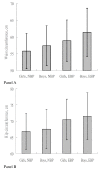Waist circumference and risk of elevated blood pressure in children: a cross-sectional study
- PMID: 21810218
- PMCID: PMC3160994
- DOI: 10.1186/1471-2458-11-613
Waist circumference and risk of elevated blood pressure in children: a cross-sectional study
Abstract
Background: Increasing childhood obesity has become a major health threat. This cross-sectional study reports associations between schoolchildren's waist circumference (WC) and risk of elevated blood pressure.
Methods: We measured height, weight, neck and waist circumference, and blood pressure in regular health examinations among children in grade 1 (ages 6-7 years) at six elementary schools in Taipei County, Taiwan. Elevated blood pressure was defined in children found to have mean systolic or diastolic blood pressure greater than or equal to the gender-, age-, and height-percentile-specific 95th-percentile blood pressure value.
Results: All 2,334 schoolchildren were examined (response rate was 100% in the six schools). The mean of systolic and diastolic blood pressure increased as WC quartiles increased (p < 0.0001). The prevalence of elevated blood pressure for boys and girls within the fourth quartile of waist circumference was 38.9% and 26.8%, respectively. In the multivariate logistic regression analyses, the adjusted odds ratios of elevated blood pressure were 1.78 (95% confidence interval [CI] = 1.13-2.80), 2.45 (95% CI = 1.56-3.85), and 6.03 (95% CI = 3.59-10.1) for children in the second, third, and fourth waist circumference quartiles compared with the first quartile. The odds ratios for per-unit increase and per increase of standard deviation associated with elevated blood pressure were 1.14 (95% CI = 1.10-1.18) and 2.22 (95% CI = 1.76-2.78), respectively.
Conclusions: Elevated blood pressure in children was associated with waist circumference. Not only is waist circumference easier to measure than blood pressure, but it also provides important information on metabolic risk. Further research is needed on effective interventions to identify and monitor children with increased waist circumference to reduce metabolic and blood pressure risks.
Figures
References
Publication types
MeSH terms
LinkOut - more resources
Full Text Sources
Medical


